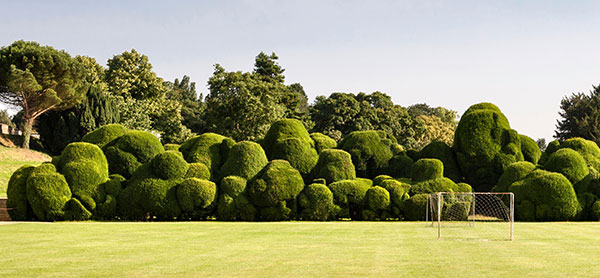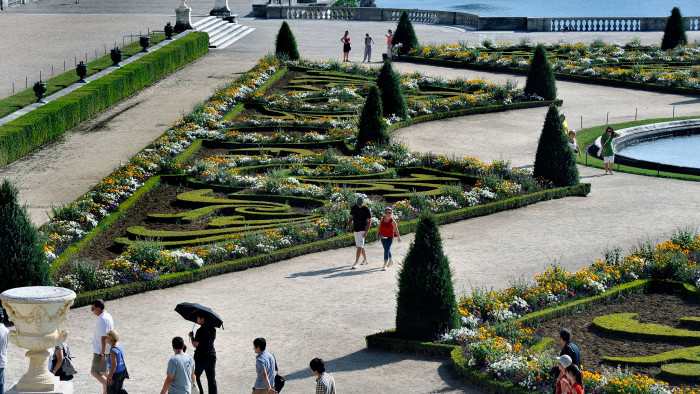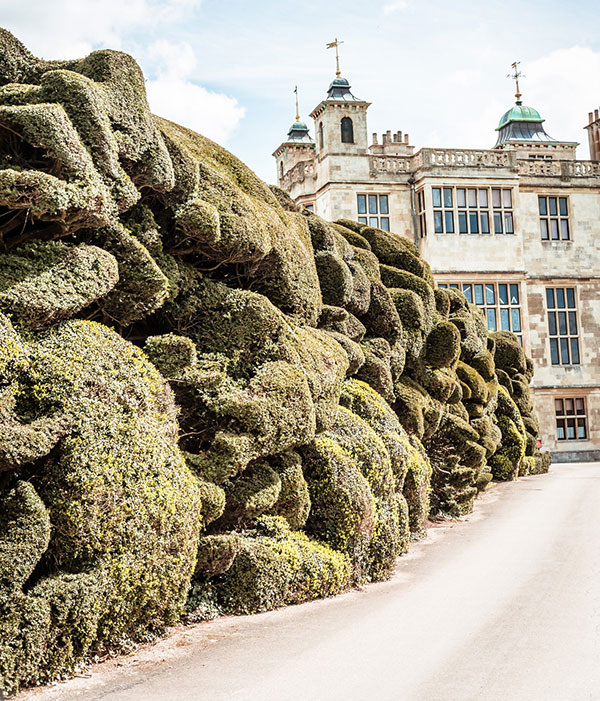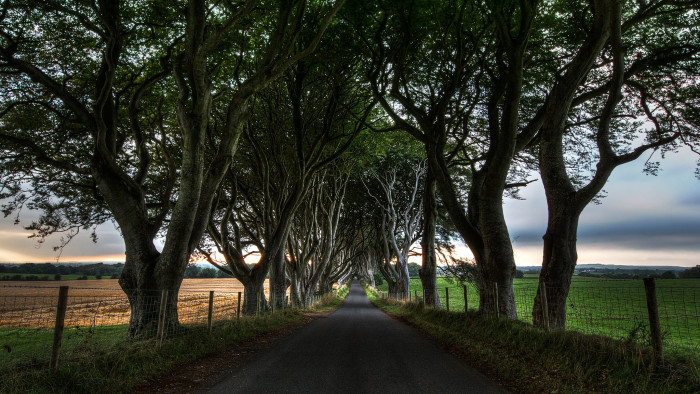In the thicket of it: a history of hedges

Simply sign up to the Life & Arts myFT Digest -- delivered directly to your inbox.
Hedges have formed a component part of our gardens for at least 2,000 years. Among the earliest examples are those used in the landscaping of Roman villas. Pliny the Elder (AD23-AD79) makes frequent references to box hedges being used to line paths. Pliny the Younger (cAD62-cAD110) writes in Letters about the gardens of his villa in Tuscany, which featured plenty of hedges and topiary, describing them as “embellished by various figures and grounded with a box hedge”. The recreated gardens at Fishbourne Roman Palace in Chichester, West Sussex, built in AD75 (at about the same time as the Colosseum in Rome) demonstrate how the use of box hedges may have looked at the time.
Hedges re-emerged from the Dark Ages as a component of medieval monastic and palace gardens, but really came into their own from the late Tudor period with knot gardens, where formal beds were edged with neatly trimmed box. These, in turn, were a step on the way to the parterre, arguably the zenith of intricate low-hedge arrangement. Clipped into elaborate scrolls and twirls, and used to frame trimmed grass or raked gravel, parterres represented an unabashed celebration of the hedge.
Het Loo Palace in the Netherlands and Versailles in France epitomise the grandeur and complexity of the parterre, which waned through the picturesque and landscape garden styles of the 18th century and then took off again in the 19th century, with designs such as that of William Nesfield at Harewood House in Yorkshire. The intricate low hedges of his terrace make an aesthetic and historic contrast to the Capability Brown landscape beyond.
Fashion aside, all that is required for hedges to shape-shift — unlike any other garden feature — is a few years without a regular trim, and some of the most remarkable examples have developed as a result of neglect and the passing of time. Beech and hornbeam are among the most popular formal hedge plants and, left untrimmed, grow into substantial trees. Perennial favourite yew can grow 20 metres high and even the apparently diminutive box will, depending on variety, slowly work its way up to nine metres or so when spared the clippers. Lacking attention, even for a short period, the component plants of any hedge will grow as trees again, inexorably reverting to their native state.
During the late 1600s an extensive knot garden was planted at Fairlawne near Tonbridge, Kent, which can be seen in a Kip and Knyff engraving of c1707, occupying a vast corner of the grounds. By the mid 1980s a lack of maintenance over more than a century had resulted in the yew hedges that formed the knot morphing into a bizarre forest. At just a few feet apart, each plant had grown tall and straight, forming a cathedral of linear, leafless trunks at the top of which was a canopy of dense, gloomy foliage. It was impossible to reconcile the original design intent with what remained. This one-off forest of yews was destroyed, almost to the last, in the great storm of 1987.

At Baldersby Park in North Yorkshire there is a narrow strip of mixed tree and shrub planting that looks like little more than a planted windbreak belt. Yet in part, at least, it is a grown-out hedge of mixed yew and box, the former tall and goblet-shaped, the latter a mass of spindly, wandering stems and loose pads of foliage, perhaps as old as the early 18th-century Baldersby Park House.
This combination of box and yew can be seen in a number of grand gardens, including Audley End near Saffron Walden, Essex. The so-called Cloud Hedge was planted there between 150 and 200 years ago and maintained as a formal, linear feature until the outbreak of the second world war. During those six years the lack of manpower meant the hedge was infrequently cut. Heavy snowfalls then caused sections to collapse, so when the gardeners took up their clippers once more they needed to take a different approach to maintenance. “Over 75 years the shape of the hedge has been refined into the cloudlike form you see today,” says head gardener Alan North. “It takes four weeks to cut, using cherry pickers, ladders and battery-powered clippers”.

The Elephant Hedge at Rockingham Castle near Corby, Northamptonshire, is even older and more outgrown than the Cloud Hedge. Planted more than 400 years ago as a double row of yews with a walkway between, the hedge survived the royalist siege of Rockingham during the English civil war and now forms a conglomeration of bulbous curves, scrolls and plumes, into which elephantine shapes can be imagined.
Perhaps the most evocative of all aged hedges can be found near Ballymoney in Northern Ireland. Planted by the Stuart family in the 18th century to create a grand entrance to their mansion, Gracehill House, the Dark Hedges were probably conceived as an avenue. Over the centuries the beech trees have grown together from side to side and at the crowns, with the result that the road beneath is effectively inside a tunnel of intertwining grey stems. So mysteriously compelling are the Dark Hedges they were used as a location for the HBO fantasy drama Game of Thrones.

Yet there is one species of plant that in recent years has given the garden hedge a rather less than glowing reputation. In 1847, Liverpool-based banker Christopher Leyland gave his nephew John Naylor and his new bride the gift of Leighton Hall in Powys, mid-Wales. Naylor commissioned Edward Kemp, a pupil of Sir Joseph Paxton, designer of the Crystal Palace, to lay out the gardens and arboretum. Among the planting combinations that Kemp included were two species of North American conifers, Monterey cypress and Nootka cypress. In the wild, the ranges of these trees are more than 400 miles apart, but in proximity at Leighton they cross-pollinated, resulting in a new hybrid, Cuprocyparis leylandii. The Leyland cypress must have excited Victorian gardeners greatly; handsome and evergreen, it was also extremely tolerant of the pollution that plagued their cities. And it was fast growing, too — although quite how fast growing was yet to become apparent.
Leylandii can grow up to one metre a year. Today, UK tabloid newspapers overflow with stories of long-running feuds between neighbours over huge hedgerows. To help resolve such conflict, high hedges legislation came into effect in England and Wales in 2005, as an addition to the Anti-social Behaviour Act 2003, and in 2013 the High Hedges Act (Scotland) was introduced. The problem is not restricted to the UK; in 2010 the government of New South Wales, Australia, introduced legislation to curb so-called “spite hedges”, of which Leylandii is a prime culprit.
Leylandii hedges may often be portrayed as the devil in vegetal form, but even the biggest ones cannot compare with the most notorious hedge of all time. The Great Hedge of India, or Indian Salt Hedge, formed part of the Inland Customs Line established by the East India Company in the 1840s to control the movement of salt across the subcontinent, and ensure the punitive salt tax levied on the populace was paid. Running for 2,500 miles from Punjab in the north-west to the Bay of Bengal in the south-east, the line was largely made of thorny plants, such as Indian Plum, up to four metres high. Before it was abandoned in 1879, the hedge was patrolled by up to 14,000 men. Today, there is barely a trace left of it.
Matthew Wilson is a garden and landscape designer and horticultural consultant
Photographs: Alamy; Mark Parren Taylor; Getty
Comments